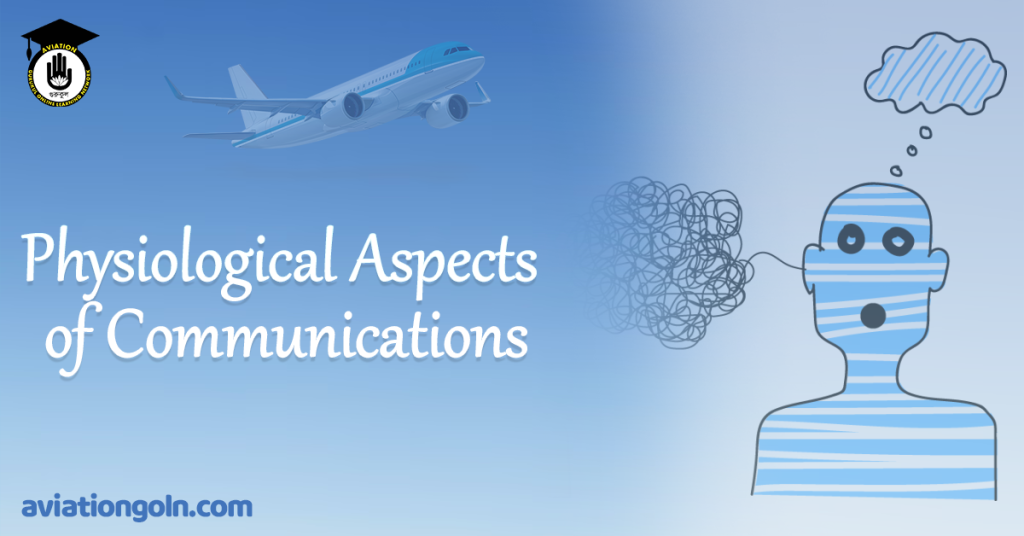Physiological Aspects of Communications
Physiological Aspects of Communications
This article is concerned with aspects of aeromedical assessments for license holders (pilots and air traffic controllers), and not specifically with aviation communication systems (technical) or communication procedures. See Related Articles below for further reading on Communication issues.
Physiological Aspects of Communications
Speech intelligibility and communication are vital elements in the safety of civil aviation. A license holder must be able to transmit and receive verbal instructions to and from the air traffic control system as well as with other crew members. In this particular respect two issues arise:
- speech intelligibility in noisy surroundings, and
- hearing under operational conditions, where many demands are made on attention from multiple sources of importance.
For this reason, license holders need to meet specific hearing test requirements which are applied during regular medical assessments.
These issues may also arise in working environments other than flight decks and air traffic control facilities, such as the Ramp. Furthermore, people providing other services at aerodromes may also experience these physiological aspects, e.g. rescue and fire fighting, de-icing, and wildlife management personnel.
Drowning Out By Noise
When sound levels within cockpits and communication systems rise, the voice must be raised to communicate against the noisy background, and if the interference becomes excessive, speech intelligibility becomes adversely affected or lost altogether.
This is auditory masking or “drowning out” by noise; it lasts only whilst the noise is present.
It represents the inability of the auditory system to separate the different tonal components and tends to be worse when the conflicting frequencies (i.e. speech and noise) are similar.
Sources of Noise
Engines, propellers, and aerodynamic sources constitute the obvious sources of noise, and aircraft design can only have a limited impact on reducing the generation of noise from these sources.
However, design can have a larger impact on providing quieter working environments where external noise is attenuated.
Noise can also be generated by:
- the cabin air conditioning system,
- electronic equipment within the cockpit,
- certain types of oxygen regulators, and
- even the individual’s breathing into a “live” microphone.
The degree of interference will depend upon the relative frequencies and strengths of the voice or tone signal and the ambient noise level. These elements, too, can be designed for quieter operation.
Headsets
Given any particular working environment, regardless of noise levels, communications will be improved by the use of headsets.
Typical communications headsets attenuate external noise whilst allowing radio communication to occur; furthermore, speaker volumes can be adjusted when necessary to improve communication.
Headsets may either passively or actively reduce external noise:
- PNR – Passive Noise Reduction.
- ANR – Active Noise Reduction.
These “muff” style headsets will also protect the users’ inner ears from damage caused by excessive noise, and prolonged exposure to lower levels of noise.
Inset-type ear protectors (foam or rubber plugs) only offer protection and do not facilitate better communication.
Language
Communication can be further facilitated by the use of special vocabulary as defined by ICAO and where necessary using “plain language”.
Related Articles
- Loss of Communication
- Prolonged loss of communication
- Communication Equipment Technical Problems
- Sleeping Receiver
- Standard Phraseology
- Read-back or Hear-back
- Communication Failure: Guidance for Controllers
- Language
- English Language Proficiency Requirements
- ATCO Language Skills
Further Reading
- Effective Pilot / Controller Communications – Airbus Briefing Note
- Pilot – Air Traffic Control Communications: it’s not (only) what you say, it’s how you say it. Flight Safety Foundation, Digest July 1995.
- ICAO Annex 10 Vol II Sixth Edition October 2001: Aeronautical Telecommunications. Vol II. Communications Procedures including those with PANS status.
- Fighting Pilot Fatigue, a video by Boeing’s Fatigue Risk Management team in partnership with Delta airlines to portray the effects of fatigue on pilots. It describes technologies in the flight deck that can monitor and prevent fatigue-related events.
References
- ICAO Doc 8984 Manual of Civil Aviation Medicine Edition 3.
- ICAO Annex 10 Vol II Sixth Edition October 2001: Aeronautical Telecommunications. Vol II. Communications Procedures including those with PANS status.
Read more:

